Blausee-Mitholz on BLS.
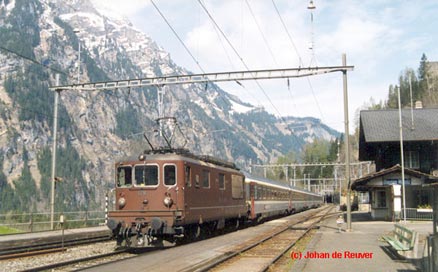
For a larger image>>>
A Re4/4 powered EC-consist passes Blausee-Mitholz.
Photo from Johan's Zwitserleven gevoel used with kind permission.
Blausee-Mitholz
A small station in a double loop.
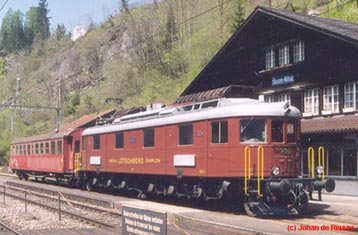
For a larger image>>>
BLS Ae 6/8 205 is the last giant of the class on the line, mainly used as a excursion power, but sometimes pressed in to freight service. The car is a old passangercar converted to MoW service..
Photo from Johan's Zwitserleven gevoel used with kind permission.
Blausee-Mitholz is situated in rather complex number of loops. The loops are partly located in tunnels and the loop makes the letter S with B-M in the very middle. There was an article in German of the station on "Eisenbahn Magazin" from november 1980. The article describes the site including few photos and a trackplan shown here. The yard consisted of set double runaround tracks and a double ended spur to loading platform and crane. The station building is located next to hillside and to the left the final switch is located next to a tunnel portal while the other side is in large loop.
The tragedy of 1947
The orginal station was destroyed in a explosion where 7000 tons of shells, hand-grenades, mines, and bombs which were stored in a tunnel or cave near the station exploded by accident shortly before midnight on the 19th December 1947. The station collapsed, 107 houses were badly damaged including 39 which were totally destroyed. Nine people were killed, including the stationmaster. The new station was built in 1948. It was open to passengers until 1987 when the local train services were replaced by buses.
To model Blausee-Mitholz
The "new" station which is the one that is available as a kit from Kibri. Remember that the kit is a old one and may not scale to even to 1:100, something that was common with the kits from the sixties and seventies. But The kit has been upgraded with more delicate details.
Fides, a Swiss manufactor of wooden craftman kits, has offered a ready built model of the station. The Kit No. is 1098. Fides wooden kits are available from www.Roundhouse.ch. There is also another line of kits from Tip-Top Model, with a number of kits based on BLS, including Blausee-Mitholz station and the small freighthouse, and Ausserberg.
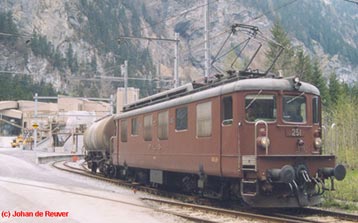
For a larger image>>>
Switching a hoppercar with a Ae4/4 at the limeworks.
Photo from Johan's Zwitserleven gevoel used with kind permission.
Further down the loop there is a track to a gravel loading bin or a tipple, and further down a combination of bridges over a creek and and a public road before entering the flagstop or a "haltestelle" for Blausee village. Inside the loop is the location of a small village, my guess that is the Mitholz downtown. And you can use 10-15 kits of various producers to dublicate the settlement of typical chalets from the area.
In the opposite direction there is a another loop to the right ending up to a small crossing station of Felsenburg, located more or less above the Blausee-Mitholz. Since the trackplan the BLS doubletracked their entire system and trackplan may have changed.
The layout would make beautyful layout, now that Roco produces an sharp looking and well performing Ae6/8, Ae 8/8 and the latest on the line Re465, along models of EW IV.s and a repainted EWII baggage car and few freightcars. As an addition some versions of Re 4/4 are manufactured by the Italian LIMA, inclueding a number of versions EW I passanger cars, AKU makes a number of freight cars from SBB and BLS. Sachsenmodelle makes models of Schlierien cars from the fifties. The line sees much foreign power as SBB RE6/6.s RE460.es and more. Some of Italian railroad companies multicurrent engines are used on the line.
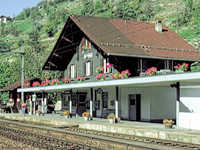
The stop Ausserberg is another small station along the line. This image shows the trace of same design, yet in smaller size compared to Blausee-Mitholz. Photo by BLS
The Felsenburg itself is not unlike Kibris station which is in the "Lenzerheide" village set. It is available separately.
Website on a layout based on the area
Michael Schröder has followed a trackplan from EK-Themen Nr. 17 "BLS" and the construction is well underway. If you are interested in the ongoing building, his web site (in german only) is well worth a visit. Modellbahnseiten von Michael SchröderBLS
The first all electric mountainline.
About BLS.
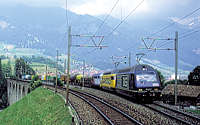
BLS Re 465 and SBB Re 460 doubleheading a freight at Kanderstegviaduct.
Photo by BLS
The BLS is a part of BLS-grouppe that also includes three other railroads, BN (Bern-Neuchätel), GBS (Gürbetal-Bern-Scwarzenburg) and SEZ (Spietz-Erlenbach-Zweisimmen). The main line Thun-Bern-Brig is only 84,336 km.s long but is today one of the busiest links in Europe. The Bern-Lötschenberg-Simplon Bahn, or BLS was and is unique in many ways. First, it was from start all electric line opened in 1913.
The foresight or hopes for increased traffic on the line, was witnessed by the construction of the lines many tunnels and bridges that were designed for a future double line in mind, or that some of the most powerful engines in the world were in use on the line. This heritage is continiued today by the delivery of the most powerful 4 axle engines of the world, the 8800 hp and 220 km/h fast engines of the Re 460-class.
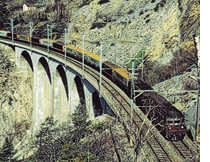
A freight on Luogekin viaduct. Note the swiss cutomary of left hand running!
Photo by BLS.
Today the line is busy doubletrack link connecting traffic from Germany in north to Italy in south and sees very heavy traffic. It also hosts some of the fasted trains of Europe, like the French TGV, German ICE and Italian CISALPINO.
The BLS is also kept busy ferrieing motorists through 14 612 m long Lötscenbergtunnel on special auto trains.
Description on Swiss engines.
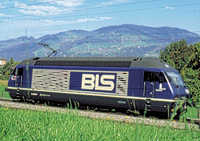
BLS Re 465.
Photo by BLS
Ae 4/4? Be 6/8? Re 460? HGe 4/4? Ge 6/6? Does this confuse you? It is rather simple way to reconize the engines, let's start backwards.
The designation 4/6 says how many of the axles are drivers. In this case Ce 4/6 says that of the engines six axles, four are drivers. This that the engine could be anything from 4-8-0, 2-8-2 or 2-4-0 + 0-4-2. The classification does NOT determinate the exact location on the drivers. An Ae 6/6 could be anything that is sixaxled, and driving with all set of axles.
Let's go to the letters, starting with some oddity. H stands for a rackengine, while G stands for Narrow gauge and the small e stand for electric. small m stands for anything that are using engines as primemovers. Oh yes, there are RhB engines that use dieselmotors and electrical current and therefor they are classified as Gem 4/4.s. RhB also uses a number of Ge4/4.s and Ge 6/6.s and to separate them they use roman prefixes to separate them. The RhB.s "Crocodiles" are Ge 6/6 I, while the sixaxled engines dating from the sixties are Ge 6/6 II.s. In same way are the four axled engines separated, Ge4/4 I.s, Ge4/4 II.s and the Ge4/4 III.s.
Now the Standard Gauge....
The Letters from A and onward describes the speed the engine is able to. run. Lets start from the fastest.
- R stands for maximimum speed of 110 km/h or more
- A stands for maximimum speed of 80-110 km/h
- B stands for maximimum speed of 70-80 km/h
- C stands for maximimum speed of 60-65 km/h
- D stands for maximimum speed of 45-55 km/h
- E stands for Switching engines.
In the early ninties, this was partially changed with a new system that is close to German but with simple fashion, the enginenumbers start with a set of three digits, the first number of axles, the second, replaces the former roman digit and third, subclasses. The Re 460 was supposed to beclassified as RE4/4 VI...